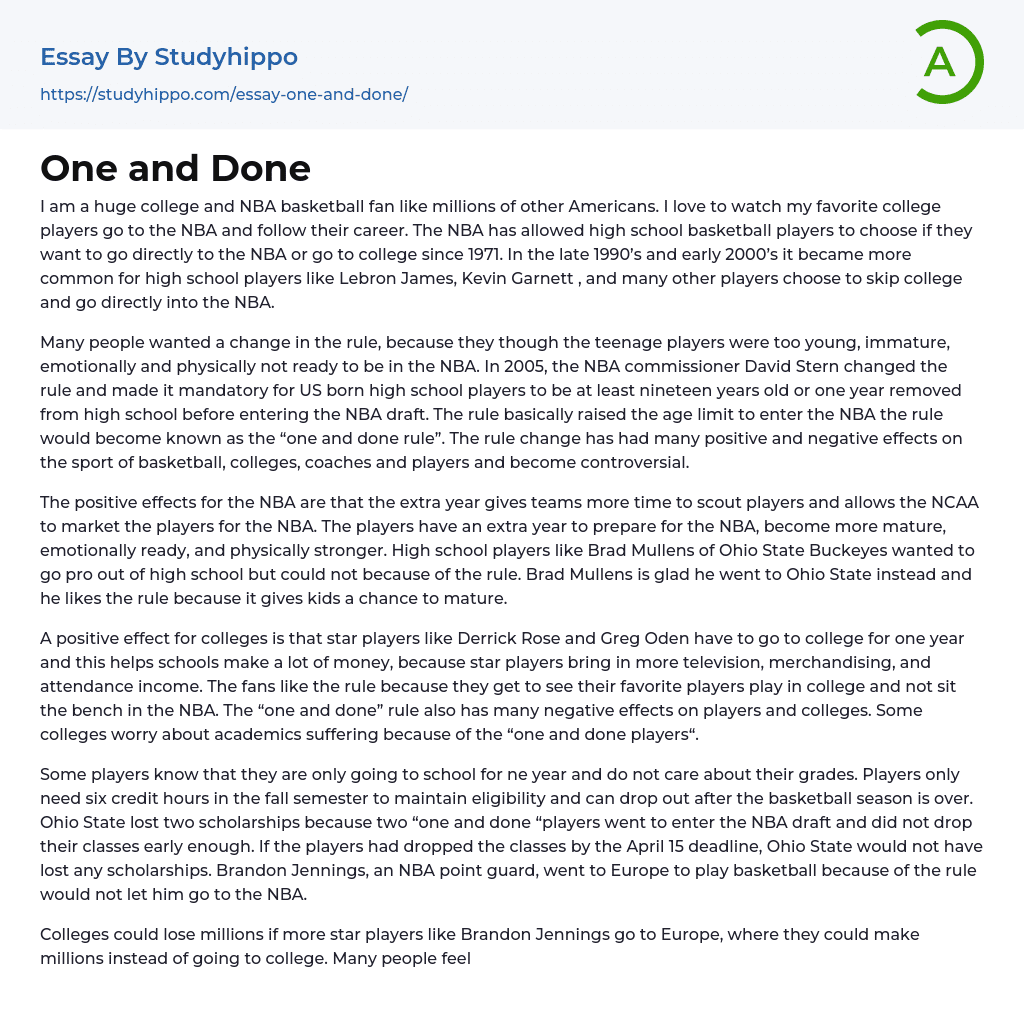Like many other Americans, I have a deep passion for both NCAA and NBA basketball. Watching the journey of my favourite college players as they rise to the NBA level is something that brings me great joy. Since 1971, high school basketball talents have been given the option to either directly join the NBA or make their way via college first. This led to a trend in the late 90s and early 2000s where notable high school players, like Lebron James and Kevin Garnett, opted to skip college and immediately start their professional careers in the NBA.
It was widely acknowledged that a change in policy was needed, as the prevailing perception was that young athletes lacked the necessary maturity and physical and emotional readiness to compete at NBA levels. As a result, David Stern, who served as NBA commi
...ssioner in 2005, revised this rule. The updated regulation stated that American-born high school athletes must either have turned nineteen or been out of high school for at least one year before they are eligible for an NBA draft. This change effectively raised the minimum age requirement to enter the NBA and is commonly referred to as the "one-and-done" rule. Since its introduction, it has had varying effects on basketball - both positive and negative - impacting basketball-related institutions, coaches, and players alike and sparking widespread discussion.
The NBA benefits from the additional year in several ways, including providing teams with more time for player scouting and giving the NCAA an opportunity to promote the players effectively for the NBA. This extra year also affords the players themselves more time to adequatel
prepare for the NBA, allowing them to mature emotionally, gain physical strength, and overall readiness. Players such as Brad Mullens from Ohio State Buckeyes initially had aspirations to go professional straight out of high school, but were unable due to this rule. However, Mullens now appreciates his attendance at Ohio State and supports the rule as he believes it offers youngsters a chance for growth.
Colleges perceive a beneficial impact when star athletes such as Derrick Rose and Greg Oden are obligated to attend college for a year, driving substantial profits due to increased television, merchandising, and attendance revenues that these players generate. Fans also appreciate this regulation as they have the opportunity to watch their preferred players perform at a collegiate level instead of being side-lined in the NBA. However, the "one and done" rule also yields unfavorable implications on both players and colleges. There are concerns among some colleges regarding the possible detriment to academic excellence due to these "one and done" players.
Some athletes are aware that their tenure in school is limited to a single year and thus, have little interest in their grade performance. To retain their eligibility, they only need six credit hours in the autumn term and can leave after the basketball season concludes. Ohio State forfeited two scholarships due to two "one-and-done" players who opted to participate in the NBA draft and did not withdraw from their classes in a timely manner. Had these players withdrawn before the April 15 deadline, Ohio State wouldn't have needed to forfeit any scholarships. NBA point guard Brandon Jennings chose to play basketball in Europe as a workaround for
the rule preventing him from entering the NBA immediately.
The possibility that elite athletes like Brandon Jennings might choose European leagues over college could result in a substantial financial loss for higher education institutions. This decision, which can earn them millions, is perceived as unfair by many and has ignited considerable controversy. A large number of players, coaches, and fans assert that limiting these athletes' earnings is unconstitutional. The argument is that if an 18-year-old is considered capable enough to be sent to Iraq, they should also have the right to play professional basketball in the NBA. Respected college basketball coaches such as Bill Self from Kansas and Tom Izzo from Michigan State have expressed strong condemnation of this rule; they maintain it's unjust not giving players the freedom to determine their career paths.
The regulation has impacted player recruitment as athletes can depart after a mere year, leading to gaps in team rosters. Evidently, the NBA's contentious move to increase the age limit has had numerous benefits and drawbacks for the NBA, educational institutions, and players themselves. Presently, the NBA is experiencing a lockout, and this matter is among the final topics under discussion. A potential amendment to this rule could bring about a variety of new implications for players, educational establishments, coaching staff, and the NBA as a whole.
- Kobe Bryant essays
- Money essays
- Financial Accounting essays
- Market Segmentation essays
- Supply And Demand essays
- Purchasing essays
- Forecasting essays
- Legacy essays
- Bank essays
- Corporate Finance essays
- Financial News essays
- Financial Ratios essays
- Financial Services essays
- Free Market essays
- Shareholder essays
- Personal finance essays
- Equity essays
- Financial Crisis essays
- Banking essays
- Credit Card essays
- Currency essays
- Debt essays
- Gold essays
- Loan essays
- Enron Scandal essays
- Foreign Exchange Market essays
- Investment essays
- Venture Capital essays
- Stock Market essays
- Retirement essays
- Donation essays
- Net Present Value essays
- Income Statement essays
- Commercial Bank essays
- Debit Card essays
- Deposit Account essays
- Subprime Lending essays
- Perfect Competition essays
- Underwriting essays
- Synergy essays
- Valuation essays
- Investing essays
- Asset essays
- Depreciation essays
- Discounted Cash Flow essays
- Foreign Direct Investment essays
- Funds essays
- Internal Rate Of Return essays
- Revenue essays
- Day Trading essays




